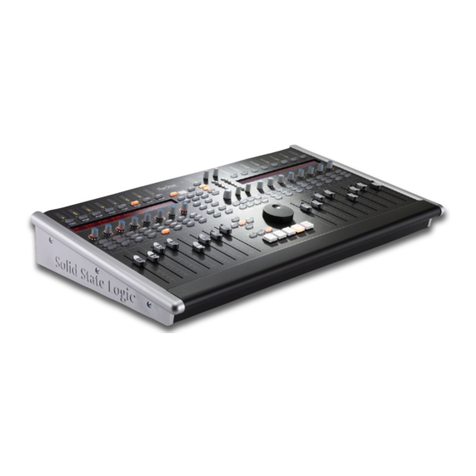Page 2 Nucleus2 User Guide
HOW TO USE THIS MANUA
After this introduction, you will find a quick overview of Nucleus2, followed by more detailed sections covering installation,
use of the Nucleus2 Logictivity Remote, and general Nucleus2 operation.
Conventions
Throughout this manual, the following conventions will be used:
• Labels found on the Nucleus2 control surface are indicated in capitals IKE THIS.
• Labels and text shown in the Nucleus2 Remote or other computer dialogues are indicated in bold ike This.
•The few instances where we refer directly to computer filenames etc. will be shown
Like This
.
•Where necessary, DAW computer keyboard key strokes will be shown
like this
whilst function keys (as opposed to
normal numbers, symbols and characters) such as the ‘Control’ key will be shown with ‘angle’ brackets such as
<Ctrl>
.
• Where DAW protocol commands appear, the command or function will be shown with ‘curly’ brackets {
like_this}
.
Notes and additional information appear like this.
• The Nucleus2 Logictivity Remote app will in some cases be abbreviated to just ‘Remote’.
• The Nucleus2 itself may be refered to either by name, as the ‘DAW controller’ or as the ‘control surface’.
Please be aware that screenshots shown may differ slightly in appearance from their on-screen equivalents.
Glossary
The following terms are either concerned with general DAW control, or specific Nucleus2 operations:
CC ayer A Continuous Controller (‘CC’) Profile for use with MIDI devices.
Dante Digital Audio Network Through thernet. A combination of software, hardware, and network protocols that
deliver uncompressed, multi-channel, low-latency digital audio over a standard thernet network.
DAW Digital Audio Workstation. Software which emulates a recording studio, such as ProTools, Logic and Nuendo.
ipMIDI MIDI control data sent over thernet.
HUI Human User Interface. The DAW control protocol used by ProTools and others.
ayers Different DAW programmes, one of which can be controlled by Nucleus2 at a time, though all transports can
be activated simultaneously from one transport master.
MCU Mackie Control Unit. The DAW control protocol used by Logic, Nuendo and others.
SD Card An SD memory card fitted to the rear of Nucleus2 for Profile storage.
Soft Keys Many switches on Nucleus2 can be programmed through the Nucleus2 Remote to perform DAW specific
functions. These switches are grouped together as ‘soft key sets’.
USER The USER and USER switches located in the centre section area of Nucleus2 are used to apply soft key
sets to the switches above and below the scribble strip displays.
V-Pot In-channel rotary encoder used to control a variety of parameters. The V-Pot is located below the digital display.
V-Sel In-channel encoder switch, used to control a variety of parameters, often associated with the V-Pot. The switch
is activated by pressing the V-Pot. Note that the VSE switch is different from the channel select (SE ) switch.
Software Versions
The information in this manual is correct for Nucleus2 software V2.0/1 or greater, Nucleus2 firmware V2.0/0 or greater
and Nucleus2 Browser V2.0/0 or greater.
Help!
Should you require assistance with Nucleus2 that is not addressed by this manual, please refer to the Support pages of
the SSL Website at www.solidstatelogic.com/support/Nucleus2 and click on ‘Ask a Question’ to get in contact with us.




























